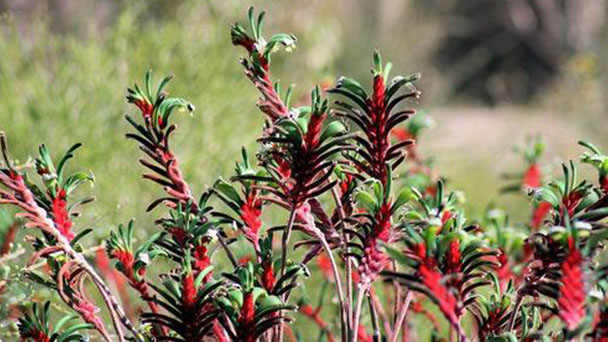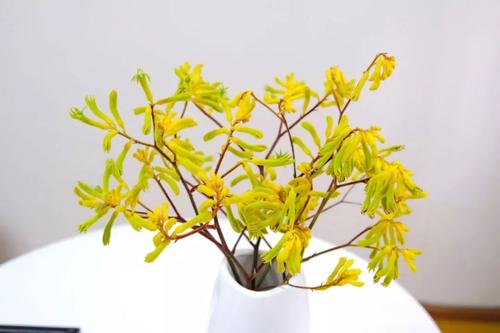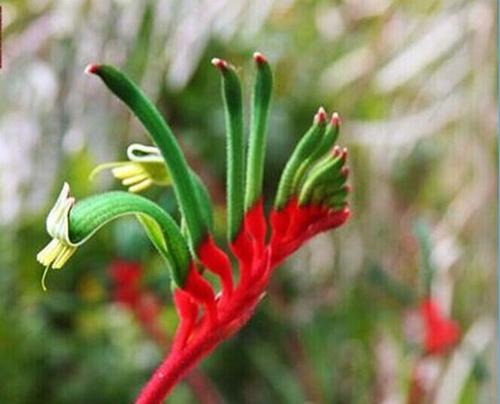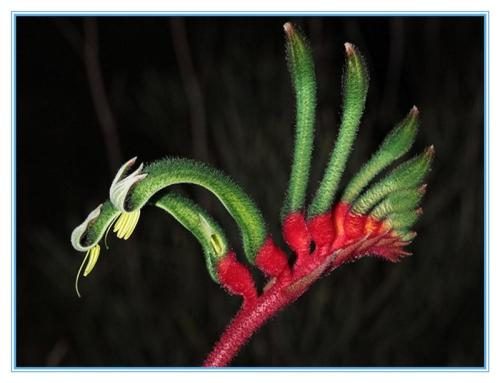Kangaroo paw (Anigozanthos) profile
Written by Maggie
May 14 2021

Kangaroo Paw (Anigozanthos) is one of the most famous wild flowers in Australia. Kangaroo Paw is grown in Western Australia which is known as the "Wild Flower State". The plant's bouquet is shaped like the claws of the famous Australian marsupial kangaroo, hence its name. There are several varieties of the Kangaroo paw produced in Australia, of which the most famous is the exotic and beautiful red and green Kangaroo paw which has been chosen as the state flower of Western Australia.
Kangaroo Paw picture

Kangaroo Paw info
| Botanical Name | Anigozanthos |
| Common Name | Kangaroo paw, cat's paw |
| Plant Type | Herbaceous perennial |
| Mature Size | 2 to 10 feet tall and 1 to 2 feet wide |
| Sun | Full sun |
| Flower Color | Red, orange, yellow, pink, purple, white |
| Hardiness Zones | 10 to 11 |
| Native Area | Australia |
Kangaroo Paw morphological characteristics
Kangaroo Paw is a perennial herb, plant height 40-120 cm.Branches and leaves fascicular, leaf lanceolate strip, leaf color gray green.Terminal raceme, labiate corolla, resembles kangaroo claw, flower stem often branched, is villous, color has orange yellow, yellow, red, green, etc.
Kangaroo Paw growing environment
The temperature
In Australia, the Kangaroo paw is mostly cultivated on land and grows under full light.Since it is hot in summer and warmer in winter, Kangaroo Paw has a high tolerance to heat but not cold.Kangaroo Paw can suffer from freezing damage under mild frost. It can be cultivated outdoors on land or in the winter in the development of Yang. It can also be cultivated in greenhouse in many areas.Kangaroo Paw grew well at 15 ℃ to 18℃, but strong light was needed. In the early stage of growth, higher temperature could promote root growth.A lower temperature is needed at the beginning of flowering to ensure bright colors and strong stems.Do not shade because you need strong light.Shading reduces temperature but also blocks the light that plants need to grow.
Moisture
Kangaroo Paw does not like higher air humidity, relative humidity of 70 to 80 percent is appropriate.High air humidity is easy to appear black spot.Too dry air will slow down the growth of plants.So keep the air moving.In many cases, sprinkling is the best way for a Kangaroo paw to absorb water. It does not harm the flowers, but it spreads pests and diseases, causing the plant to rot.Tidal irrigation can also be used, but this kind of centralized watering tends to dry out the substrate quickly and the air is dry.The best way to water is an eyedropper, which can keep the foliage dry and not prone to pests and diseases.Watering time can only be in the morning, and to avoid rainy weather, after watering the basin soil can not water, especially when the weather is cold.Kangaroo claws do not need too much water at the early stage of cultivation to avoid excessive watering.High water content is needed during vigorous growth and flowering period, and kangaroo claw is very sensitive to water shortage during this period.
Light
Kangaroo Paw is a diurnal neutral plant. It blooms in both long and short daylight conditions, but it will be more colorful in long daylight conditions.The reason is not only the effect of the length of the sun, but also the accumulation of light.Light can promote flowering, color accumulation.The better the light, the better the quality of the flowers. It is also important to reduce the night temperature to improve the variety and color of the flowers while making full use of the light.Avoid weak light and high temperature during the growth and flowering period, otherwise the plants will grow unfertilized, resulting in delicate plants and pale flowers.
Fertilizer
Kangaroo Paw is not very fond of fertilizer, and overfertilization will cause leaf disease.The EC value is between 0.8 and 1.0, which is suitable for plant growth. Kangaroo Paw is sensitive to phosphorus fertilizer. Phosphorus concentration less than 3% is prone to cause deficiency.The ratio of potassium to nitrogen can increase as the plant grows.The pH value should be less than 6.5 or iron deficiency is likely to occur.Thin fertilizer application has a good effect on kangaroo claw.
Kangaroo Paw distribution range
Kangaroo Paw distributes in Australia.
How to grow and care for Kangaroo Paw
Light
These flora pick to develop in full sun. At least six hours of direct daylight on most days will allow kangaroo paw flowers to produce the nice increase and blooms. They can even tolerate severe mild from warm afternoon sun. Insufficient mild can reason tall vegetation to flop over and reduce bloom production.Soil
These vegetation naturally develop in sandy soil with a barely acidic soil pH. But they can tolerate a range of soil types, as lengthy as there is exact drainage. For container plants, use an all-purpose potting combine amended with a few handfuls of sand.Water
Kangaroo paw flora pick a average quantity of soil moisture, even though they have some drought tolerance. Soggy soil can purpose root rot and kill the plants. So wait till the pinnacle couple inches of soil are dry to the contact earlier than watering. However, in the spring and summer season when most of the blooming occurs, kangaroo paw does recognize some extra water.Temperature and humidity
These flora thrive in the heat, and frost can be deadly to them. They like temperatures between roughly 70 and eighty ranges Fahrenheit. And as soon as the temperature falls beneath 50 stages it is time to carry them inside. They additionally naturally thrive in dry stipulations however can tolerate some humidity, too.Fertilizer
Kangaroo paw plant life are not heavy feeders, so normal fertilizer isn't always necessary. In the spring earlier than the flower stalks appear, add a cup or two of compost to the soil to promote wholesome growth.Pruning
Kangaroo paw plant life reply properly to heavy pruning. Cut returned the plants—leaves, flower stalks, and all—to 6 inches above the soil line after the blooms have faded. This will stop historic foliage from turning into diseased and promote denser growth. You additionally may be rewarded with a second, smaller flush of blooms towards the cease of the developing season.
Propagating Kangaroo Paw
If you are patient, you can propagate your kangaroo paw vegetation from seed planted in the spring. Presoak seeds in warm water for two hours to soften the seed coat and expand the probabilities of germination. Place them on warm, moist seed-starting soil. Keep the soil moist, and do not supply up on germination till at least six weeks have passed. You additionally can propagate the plant life by using division, slicing aside mature flora at the roots with a sharp knife and replanting them anywhere you desire. Dividing flora each few years also can assist to promote healthful growth.Varieties of Kangaroo Paw
From the wild species, breeders have labored to create cultivars with elevated sickness resistance and showier flowers. Some popular kangaroo paw flora include:Red and inexperienced kangaroo paw (Anigozanthos manglesii): The floral logo of Western Australia, this plant produces inexperienced and pink plants and stems.
Tall kangaroo paw (Anigozanthos flavidus): This species aspects plant life that are normally a yellow-green colour and grows to round 6 ft tall.
Little kangaroo paw (Anigozanthos bicolor): This plant stays much less than two ft tall and produces yellow-green and pink flowers.
Kangaroo Paw pest control
The most common disease in Kangaroo paw is black spot, root rot, rust and so on.Many factors can cause black spot of kangaroo claw, such as frost, drought, excessive watering, lack of nutrients, high humidity, mechanical damage and so on.And high air humidity is the cause of many diseases, so we should maintain the circulation of air, avoid high air humidity, do a good job of protection.
Kangaroo Paw uses
Kangaroo paw flower is peculiar, very beautiful, commonly used as cut flower cultivation, but also suitable for potted indoor beautification.

Latest Updated
- Benefits of Bugleweed - 7 Science-backed Health Benefits
- Bugleweed Dangers & Side Effects - Is It Poisonous?
- How to Plant Evergreen Trees - What You Should Know
- When to Plant Evergreens - Grow Guide for Evergreen Trees
- 12 Wonderful Evergreen Shrubs for Your Garden
- 12 Popular Evergreen Plants with Pictures for Beginners
- When And How To Prune A Lilac Bush Like a Pro
- How to Grow & Care for Lilac Vine (Hardenbergia Violacea)
- Japanese Lilac Tree (Syringa Reticulata) Care & Propagation Guide
- Shumard Oak Pros and Cons - What to Know
Popular Articles
- Winter maintenance of Antirrhinum Majus
- How to Grow Terminalia Mantaly Tree
- How to Grow and Care for Crossostephium Chinense
- How to grow Antirrhinum Majus in spring
- Peristeria Elata (Dove Orchid) Profile: Info & Care Guide
- Underwatered Snake Plant (Sansevieria Trifasciata) - Signs And How To Fix
- How to Care for Brazilian Jasmine Plant (Mandevilla Sanderi)
- How to Grow & Care for Graptopetalum Purple Delight in Summer
- Rosa Chinensis (China Rose): Plant Growing & Care Tips
- How to Care for Baby Sun Rose (Aptenia Cordifolia)